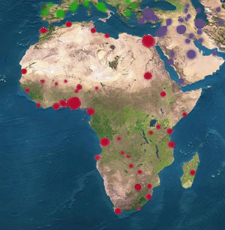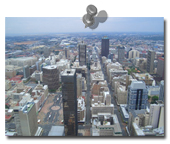2. Urbanisation
Africa

In the year 2000, Asia and Africa were the least urbanised continents, but the future population growth and rapid urbanisation will occur in Africa and Asia, especially in sub-Saharan Africa (Dutt, Noble 2003, Soja, Kanai 2007).
The development and growth of cities in Africa is producing regional differences with some giant congested areas like Cairo, Lagos and Kinshasa (Gresh 2007).
Though Africa is predominantly rural, it has 37.3% living in urban areas in 1999, a growth rate of around 4%. In some countries of sub-Saharan Africa the urbanisation rate exceeds 4 to 5% per year. Sub-Saharan Africa is urbanising faster than any other continent (some cities grow more than 10% annually, implying that the population doubles every decade) that it can expect an urban majority by around 2030 (UN-HABITAT 2001).
In 1960 Johannesburg was the only city exceeding 1 million inhabitants in sub-Saharan Africa, in 1970 there were four (Cape Town, Johannesburg, Kinshasa and Lagos). By 2010, sub-Saharan Africa will have at least 33 cities of more than 1 million inhabitants, two cities exceeding 5 million (Cairo and Lagos) and one (Lagos) having more than 13 million people (UN-HABITAT 2001).
Cairo
The Cairo metropolitan area has increased from 2.4 million in 1965 to about 10 million today and is predicted to reach 11.5 million by 2015. Within the city, population densities are some of the highest in the world and the urban area is now more than 400 square kilometers in extent. The next big city, Alexandria is about 200 km away, but the spread of low-density residential developments probably will merge both cities into a single and huge Nile Delta metropolis in the future (UN-HABITAT 2001).
Tasks: 1. Describe the urbanisation process in Africa.
2. Explain the particularities of this urbanisation process.
Case study: Johannesburg

